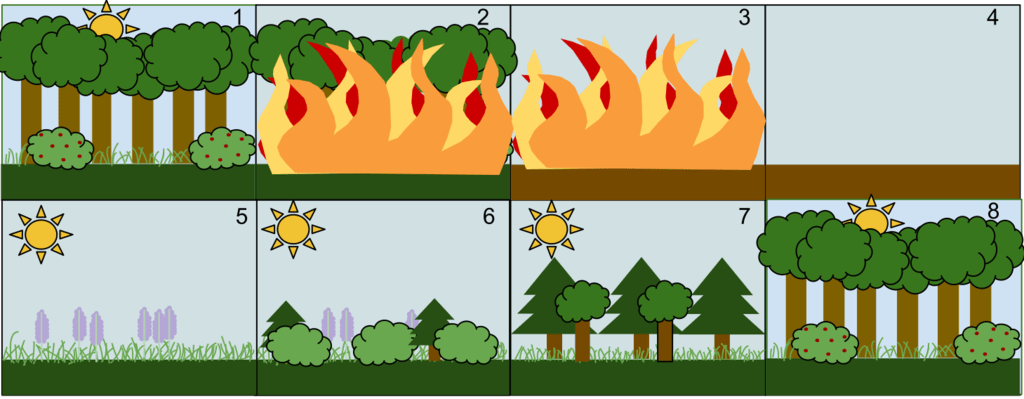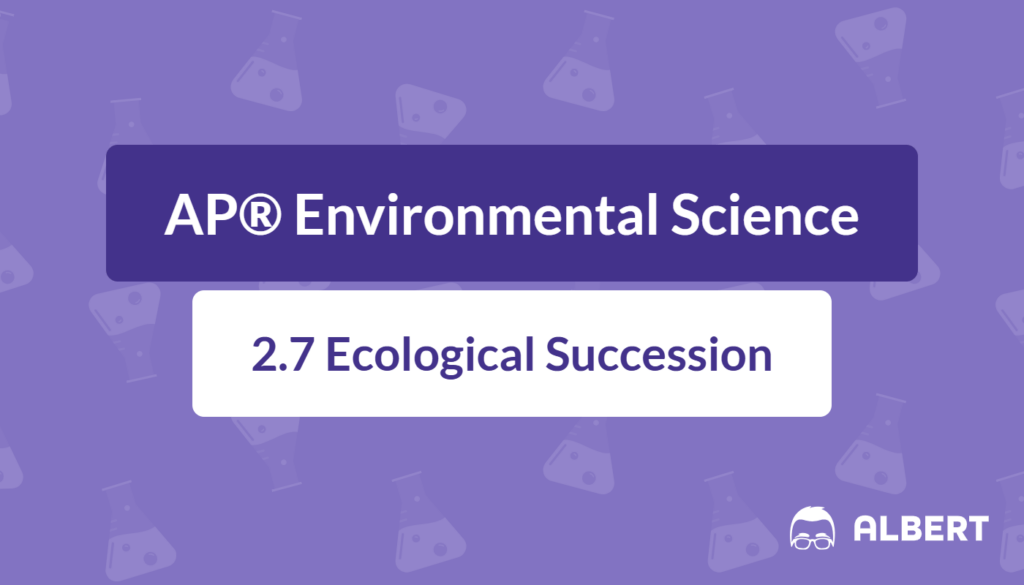What We Review
Introduction to Ecological Succession
Ecological succession refers to the predictable series of changes in species composition in a given area over time. Organisms transform their environment, which then paves the way for new species to settle. Eventually, an ecosystem often transitions toward a stable, long‑term community known as the climax community.
Understanding how ecological succession works is essential. However, it is equally important to note that many ecosystems never reach a true climax or remain in constant flux. For example, frequent disturbances like storms or wildfires can repeatedly shift an ecosystem back to earlier successional stages. Therefore, studying succession gives insights into how ecosystems recover, maintain resilience, and sustain biodiversity.
There are two principal types of ecological succession:
- Primary Succession
- Secondary Succession
Primary succession occurs on surfaces where no soil exists initially, whereas secondary succession takes place in previously inhabited areas that have been disturbed. Both versions are guided by changing resource availability, species interactions, and environmental patterns.
The Two Types of Ecological Succession
Primary Succession
Primary succession takes place in areas devoid of soil or sediment, such as newly formed volcanic islands or landscapes scraped bare by glaciers. During this process, species gradually build habitats from virtually nothing. Furthermore, harsh conditions limit life at first, so the earliest settlers often possess special survival traits.
1. Definition and Characteristics
- Occurs on bare rock or other surfaces where no soil remains.
- Involves the gradual formation of soil by pioneer species and physical weathering.
- Starts with organisms that can withstand extreme conditions (e.g., lichens and mosses).
2. Example of Primary Succession: Volcanic Island Development
Consider a newly formed volcanic island that has solidified lava and no established soil layer. The steps below illustrate how life might take hold:
- Bare Rock Formation: Lava cools and forms solid rock. This inhospitable surface offers minimal moisture and nutrients.
- Pioneer Species Arrival: Wind carries spores of lichens, which attach to the rock surface. These organisms secrete acids that slowly break down the rock, contributing to the initial soil formation over several years.
- Thin Soil Layer Accumulation: As lichens and mosses die, their organic material mixes with rock particles. This process builds a thin layer of soil.
- Larger Plants Appear: Grasses and small herbs root in this emerging soil, further enriching it with organic matter.
- Shrubs and Trees Colonize: Over time, more robust plants, such as shrubs and small trees, take hold. They provide shade, alter nutrient cycles, and encourage more complex species interactions.
- Mature Community: Eventually, a forest or other complex vegetation community may grow if climate and other factors remain stable.
Secondary Succession
Secondary succession unfolds in regions where soil already exists but a disturbance has cleared out much, if not all, of the vegetation. This process can be observed in areas recovering from events such as wildfires, floods, or human‑made disruptions.
1. Definition and Characteristics
- Occurs on land with pre‑existing soil.
- Often proceeds faster than primary succession because the substrate is already established.
- Pioneer species quickly occupy disturbed areas, yet the community can evolve over time as other species arrive.
2. Example of Secondary Succession: Forest Recovery After a Wildfire
Consider a forest region devastated by a severe wildfire. Although many plants and animals perished, the soil remains in place. Here is a step‑by‑step look at the recovery:
- Post‑Fire Environment: After the flames subside, charred remains of trees stand over burned soil. Yet, the underlying seed bank may remain partially intact.
- Early Plant Colonizers: Hardy grasses and flowers reappear first. They benefit from reduced competition and elevated nutrient levels as ash adds minerals to the soil.
- Shrubs and Saplings: As conditions improve, shrub species establish roots. Tree saplings that survived below ground or in nearby areas begin to grow.
- Expanding Forest Canopy: Over time, tree growth creates a denser canopy. This shading impacts grasses and low‑lying plants, changing species composition.
- Return of Mature Forest Community: Eventually, the community may resemble its pre‑fire state, though some shifts in species mix can occur if conditions, such as climate or pest outbreaks, have changed.

Key Concepts in Ecological Succession
Several key terms help illustrate the roles of different organisms during succession, as well as how those organisms shape ecological recovery.
Pioneer Species
Pioneer species are the initial colonizers of barren or disturbed areas. They tend to be hardy, able to withstand extreme conditions, and often produce vast numbers of offspring. In primary succession, lichens fit this description. In secondary succession, fast‑growing grasses can play a similar role. These species modify the substrate by adding nutrients and organic matter. Therefore, the process makes it easier for other species to establish themselves over time.
Example of a Pioneer Species:
A common pioneer species in rocky environments is the lichen. Lichens create microhabitats by weathering rock surfaces and introducing organic matter. Consequently, they help initiate soil formation and pave the way for mosses, small herbs, and eventually more complex plants.
Keystone Species
A keystone species significantly influences community structure and overall ecosystem function. This species may control the population of another organism, provide critical resources, or shape the environment in a way that affects many other species.
Example of a Keystone Species:
In some temperate forests, beavers regularly alter water flow by constructing dams. These dams create wetlands that support a diverse range of amphibians, aquatic plants, and other wildlife. Removing the beaver would drastically change the ecosystem’s hydrology, leading to considerable losses in species diversity.
Indicator Species
Indicator species reflect specific ecosystem conditions. Their presence, absence, or abundance points to environmental changes, such as pollution or habitat degradation. Consequently, scientists can monitor indicator species to diagnose problems early before an entire ecosystem suffers.
Example of an Indicator Species:
Brook trout (Salvelinus fontinalis) in freshwater streams are highly sensitive to water pollution and increased temperature. A decline in brook trout often signals deteriorating stream quality, prompting experts to investigate possible causes, such as acid rain or chemical runoff.
The Effects of Ecological Succession on Ecosystems
Ecological succession influences ecosystems by modifying available habitat, altering species interactions, and changing the flow of energy and nutrients. Over time, these changes affect biomass, species richness, and net productivity.
Impact on Biomass
As an ecosystem matures, plant and animal populations expand when resources are plentiful. The accumulation of plant material reduces erosion, increases carbon storage (benefiting elements of the carbon cycle), and improves habitat complexity. Biomass often rises in later successional stages until limiting factors disrupt further growth or cause a shift in the community.
Impact on Species Richness
In the early stages of succession, only a few species can survive extreme conditions. However, as soil quality improves and habitats develop, a greater variety of organisms can flourish. Thus, species richness typically increases over time. Nevertheless, competition eventually intensifies, which may cause certain species to decline or relocate, maintaining a dynamic balance.
Impact on Net Productivity
Net productivity, the amount of energy available to higher trophic levels after accounting for respiratory losses, changes with succession. Early successional stages often show high productivity because pioneer plants rapidly convert sunlight into biomass. However, the ecosystem can reach a point where productivity plateaus or declines slightly. For instance, increased shading in old‑growth forests may reduce the productivity of understory plants. A simplified version of net primary productivity is captured in the relationship:
NPP = GPP - Rwhere GPP is gross primary productivity, and R is the energy used in plant respiration.
Example of Successional Transformation: Grassland Turning into a Forest
- Grassland Stage: Grasses and herbaceous plants dominate the open area. They have high productivity and cover, but tree saplings may struggle in direct sunlight.
- Shrubs and Pioneer Trees: Over time, shrubs and sun‑tolerant tree species establish themselves. They provide shade for later arrivals and increase habitat complexity.
- Mixed Forest Development: As these trees grow, they outcompete grasses for light. The forest floor becomes cooler and more humid, favoring species adapted to lower light conditions.
- Mature Forest Ecotone: Eventually, the area can become a mature forest with multilayered canopies, supporting diverse wildlife and plant communities.
Conclusion
Ecological succession is a foundational concept in AP Environmental Science because it illustrates the predictable yet dynamic ways ecosystems evolve. From barren lands to flourishing forests, both primary and secondary succession demonstrate nature’s capacity to recover and adapt. Furthermore, pioneer species, keystone species, and indicator species all play vital roles in this ongoing process of community change.
Although this guide provides an overview, actual ecological succession is complex. Many factors, including climate shifts, human activities, and species interactions, can shape how fast or slowly succession proceeds. Observing local ecosystems and noting changes over time raises awareness of both natural cycles and potential disturbances. Recognizing these patterns supports informed environmental decisions that help sustain biodiversity and maintain ecosystem health.
Important Vocabulary
- Ecological Succession: A series of predictable changes in the composition of a community of organisms over time, often leading to a more stable ecosystem.
- Primary Succession: Succession that starts on a surface where no soil exists, such as a volcanic island or glacial moraine.
- Secondary Succession: Succession that occurs in an area with existing soil but where a disturbance has modified or removed vegetation.
- Pioneer Species: The first species to colonize barren or disturbed environments, often altering conditions to make them more suitable for other species.
- Keystone Species: A species that has a disproportionately large influence on community structure, shaping ecosystem dynamics significantly.
- Indicator Species: Organisms that reflect specific environmental conditions, serving as early warning signals for ecological changes.
Ecological succession reveals nature’s remarkable ability to renew itself. For AP® Environmental Science students, understanding the stages of succession and the roles of different species highlights essential ecological principles that inform conservation strategies, land management, and sustainable development.
Sharpen Your Skills for AP® Environmental Science
Are you preparing for the AP® Environmental Science test? We’ve got you covered! Try our review articles designed to help you confidently tackle real-world AP® Environmental Science problems. You’ll find everything you need to succeed, from quick tips to detailed strategies. Start exploring now!
- AP® Environmental Science: 2.3 Review
- AP® Environmental Science: 2.4 Review
- AP® Environmental Science: 2.5 Review
- AP® Environmental Science: 2.6 Review
Need help preparing for your AP® Environmental Science exam?
Albert has hundreds of AP® Environmental Science practice questions, free response, and full-length practice tests to try out.








